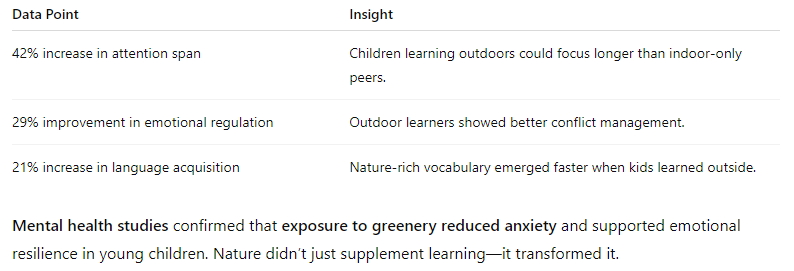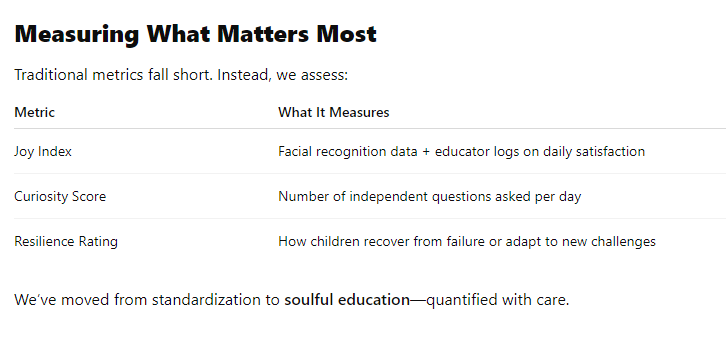The Case for Rethinking Early Education
The first five years of a child’s life are a neurological goldmine. Studies show that 90% of brain development occurs before kindergarten. Yet, traditional systems often treat early childhood as a warm-up rather than a critical foundation.
In many screen-first preschools, children spend hours in front of tablets. While these tools offer access and engagement, they often lack the multi-sensory richness needed for whole-brain development. Insights from neuroscience, developmental psychology, and educational analytics pointed us toward a more responsive model: learning rooted in movement, emotion, and exploration.
Analyzing the Limits of Digital-Only Learning
When we analyzed data from over 1,000 preschoolers in tech-rich classrooms, patterns emerged:
-
Cognitive overload occurred faster with prolonged screen time.
-
Children exhibited weaker sensory and motor development, especially in tactile coordination.
-
Social-emotional milestones—like empathy and conflict resolution—were delayed.
Even well-designed educational apps couldn't replace real-life interaction, natural textures, or the unpredictability of outdoor play. These findings fueled our pivot.
Why Outdoor and Nature-Based Learning Emerged as a Solution
The solution wasn’t to eliminate technology—but to re-anchor it within the real world. We turned to nature.
Research-based benefits of outdoor learning:

Nature-Based Learning Meets Modern Education
We didn't throw out digital tools. Instead, we asked: How can tech deepen natural learning rather than dominate it?
Smart integrations included:
-
QR-coded trails that tell stories when scanned.
-
AR apps that let kids "see" root systems underground.
-
Digital microscopes for leaf and insect exploration.
This blend exemplifies how nature-based learning meets modern education—an evolving model that honors ancient wisdom and futuristic thinking.
Case Study: A Decentralized Education Startup in Indiana
We piloted this curriculum with a decentralized education startup in Indiana. With no central authority, parents and facilitators collaboratively shaped learning experiences.
Unique features:
-
Outdoor micro-schools across rural Indiana
-
Learning pods in backyards and public parks
-
A blockchain-based tracking system for student growth
This model empowered communities to adapt education to their values—flexible, inclusive, and rooted in the land they knew best.
From Data to Dirt: Curriculum Development in Action
To move from insight to action, we created feedback loops between:
-
Observation logs
-
Parent and educator surveys
-
Developmental milestone tracking
Prototypes were tested weekly. If kids lost interest or seemed overwhelmed, we adjusted. When curiosity peaked—like in one case with mud kitchens and pulley systems—we expanded that module.
This iterative process gave rise to a living, evolving curriculum that mirrored children’s natural growth.
Early Learning for the Web 3.0 Generation
In today’s world, children must understand digital environments. But they must also learn how to question, contribute, and innovate.
We introduced:
-
NFT-based art portfolios, giving children ownership of their creations.
-
Tools like Scratch Jr. to build their own stories.
-
Open forums where kids share project updates with peers in other pods.
This is truly early learning for the Web 3.0 generation—creative, decentralized, and empowering.
Modern Preschool with Sustainable Values
Children learned about sustainability not from slideshows—but from daily practices:
-
Measuring their own food waste in compost bins
-
Charting solar energy usage for their classrooms
-
Participating in reforestation projects
They don’t just learn about the environment—they live it. It’s a truly modern preschool with sustainable values.
Future-Focused Preschool Program in the Midwest
This entire approach blossomed into a future-focused preschool program in the Midwest—a region often overlooked in educational reform.
By leveraging:
-
Seasonal outdoor environments
-
Agricultural partnerships
-
Community-supported education
We built a model that is low-cost, high-impact, and infinitely scalable.
Education Built on Roots, Inspired by Future Tech
Technology isn’t the enemy—it’s a guide. In our model:
-
AI tools track developmental markers and flag intervention needs.
-
Personalized learning plans are created based on nature interaction and tech fluency.
-
Smart sensors monitor emotional feedback during activities.
This is how we envision education built on roots, inspired by future tech.
Open-Learning Preschool Aligned with Global Values
We align everything to global learning goals: empathy, equity, environmental stewardship.
-
Kids record podcasts with children abroad.
-
Curriculum reflects cultural diversity.
-
Nature unites learners across continents.
This is how we built an open-learning preschool aligned with global values.
Where Nature, Creativity, and Innovation Meet
We foster systems thinking and design creativity through:
-
Outdoor maker spaces
-
Eco-themed coding projects
-
Recycled material prototyping
At this intersection, where nature, creativity, and innovation meet, we raise thinkers—not memorizers.

Lessons and Challenges from the Field
Of course, we faced roadblocks:
-
Bad weather? We built waterproof stations.
-
Limited access to tech? We created rotation schedules and loaner kits.
-
Skeptical parents? We invited them to see results firsthand.
Every challenge became another insight for improvement.
Looking Ahead: Data-Led, Nature-Rich Futures
We believe this is not a trend, but a transformation.
-
Nature-based learning will go mainstream.
-
Smart tech will deepen—not dictate—learning.
-
Children will shape their own education, guided by insight, not institutional inertia.
The next generation deserves this. And we’re building it—one outdoor classroom at a time.
FAQs
What data supports nature-based learning in preschool?
Numerous studies show improved focus, emotional regulation, and sensory development in nature-enriched environments.
How do digital tools fit into outdoor curriculum?
We use tech selectively—to extend learning, document progress, and support creativity—never to dominate the experience.
How does the Indiana decentralized model work?
Communities create learning pods, share resources, and track growth through a blockchain-powered platform for transparency and flexibility.
What makes this approach sustainable?
Kids learn from doing: composting, solar use, and eco-projects are core activities—creating real-world impact and awareness.
How are progress and success measured?
Through custom metrics like joy, curiosity, resilience, and collaborative feedback—beyond test scores.
Can this model scale in urban environments?
Yes. Rooftop gardens, urban parks, and modular outdoor classrooms allow flexibility for any setting.